
I’ll admit I’d been winding up Lucky Bastard for the previous two days. Mercilessly, according to some.
This article was first published in MOTOR Magazine's March 2005 issue.
So I guess it came as no surprise when he lined me up in the pits at Winton, poked me in the chest and delivered a statement that will surely haunt him. “I don’t care,” said Lucky Bastard through gritted teeth, “if Santa doesn’t come this year as long as I kick your arse out on the track today.”
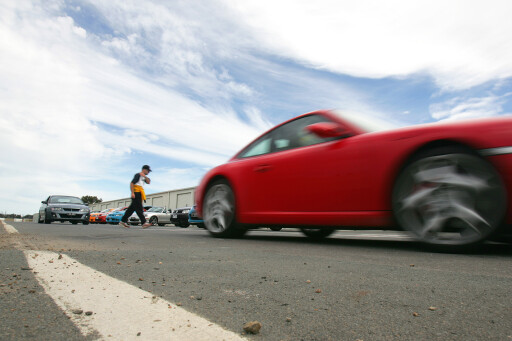 He was joking. As it turned out. But then, that’s Winton for you. It can take a brand new car and turn it into a steaming pile of poo in just a handful of laps. Or it can turn a competent road car into a rolling, wheezing, sliding heap-o-crap for no other reason than the design engineers never sampled Winton’s technical little layout in 36-degree ambient.
He was joking. As it turned out. But then, that’s Winton for you. It can take a brand new car and turn it into a steaming pile of poo in just a handful of laps. Or it can turn a competent road car into a rolling, wheezing, sliding heap-o-crap for no other reason than the design engineers never sampled Winton’s technical little layout in 36-degree ambient.
Winton is no respecter of reputation, road-smarts or law degrees (right Lucky?). That’s for sure. And it paid scant regard for the on-road abilities of close relatives the Audi TT and VW Golf R32.
Okay, so the Haldex-clutch, on-demand nature of the all-wheel drive set-up in both cars has never given many racetracks any real scares, but man, did it let this pair down. To be fair, both the TT and R32 remain very neutral when the corners start rushing up at Winton speeds, but they sure as hell move around in the process.
Both engines are fit, although the Golf’s second gear is a fraction too short even for Winton’s short straights. And the Audi’s DSG six-speeder features twice the clutches and half the fun of a proper manual. But lap-times?
 A bit duff, really, although we were surprised that the Audi was quicker (1:46.35) than the perkier feeling R32 (1:47.22). The only other two all-wheel drives this time around, however, were vastly different propositions. The EVO VIII is just as manic as we remember from Bang For Your Bucks.
A bit duff, really, although we were surprised that the Audi was quicker (1:46.35) than the perkier feeling R32 (1:47.22). The only other two all-wheel drives this time around, however, were vastly different propositions. The EVO VIII is just as manic as we remember from Bang For Your Bucks.
And it’s hard to know what to be impressed with most; the tremendous grip or the stonking engine that just doesn’t know when to quit. Upshifts in lower gears were a bit clunky and the gearbox got notchier as the oil got hotter (a very tired example, this), but while ever the tyres last, the EVO hangs in there, punching hard all the way.
Performance Car of the Year 2005 - Airport
An active centre-diff got the STi into the game again this year and it has changed the car dramatically. It’s still a bit more understeery than the Lancer and it isn’t as keen to tuck its nose back in on a trailing throttle, but it’s an absolute revelation in faster turns like Winton’s notorious sweeper.
The gearing is a bit short and that’s probably deliberate to mask the engine’s chronic torque hole below 4000rpm, but you don’t notice that on the track and the WRX has six gears compared with the Lancer’s five.
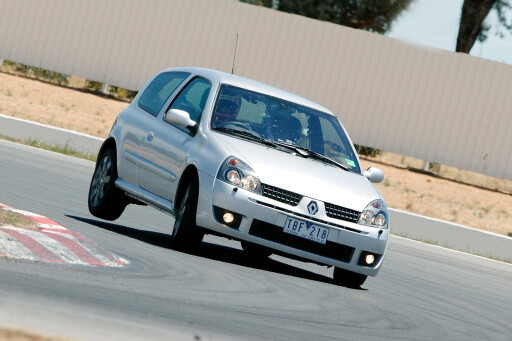 It was still over half a second off the EVO’s lap time, though with a still-creditable 1:41.47 (1:40.88 for the Mitsubishi). Front-wheel drive and a racetrack (especially a twisty one like Winton) doesn’t always make for a great combination. But the Renault Sport Clio puts that theory to the sword.
It was still over half a second off the EVO’s lap time, though with a still-creditable 1:41.47 (1:40.88 for the Mitsubishi). Front-wheel drive and a racetrack (especially a twisty one like Winton) doesn’t always make for a great combination. But the Renault Sport Clio puts that theory to the sword.
The problem with punting ordinary tail-draggers around a circuit is that the front end often loses all feel and accuracy and with it goes power-down and feedback. Not so in the Clio which just got better the harder we hammered it. Ultimately, you’ll build a small amount of push into things, but the Clio’s chassis is so throttle sensitive, it’s easily corrected.
Okay, so 1:47.16 isn’t brilliant, but the Clio honestly felt more fun than that time suggests, and that’s really the point. The biggest let down was the braking package which worked fine but lacked a little feel, especially during those moments of desperation that a track like Winton seems to produce.
Perhaps closest to the Renault in concept (if not execution) is the MINI Cooper S. The MINI must have had the sharpest, pointiest steering of this year’s field. Sometimes, you actually found yourself winding off a little lock to find the line again.
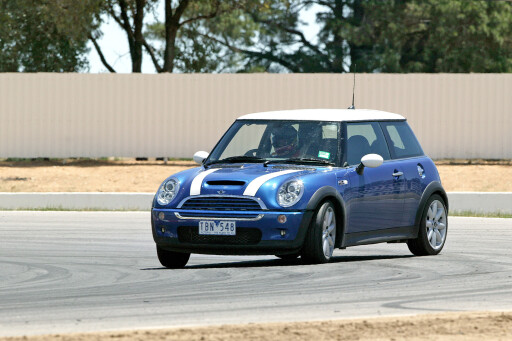 Sadly, the grip of the front-end wasn’t as good, so you’d get some push on the entry to faster corners and a lack of power-down on the exit. As such, the Cooper is one of those cars that rewards the slow-in-fast-out approach.
Sadly, the grip of the front-end wasn’t as good, so you’d get some push on the entry to faster corners and a lack of power-down on the exit. As such, the Cooper is one of those cars that rewards the slow-in-fast-out approach.
The gearbox is good with a quick, positive shift and while the supercharged engine is better with every new example of the MINI Cooper S we sample, it still feels a bit flat on the circuit. In the end, the Cooper is more or less as quick as the Renault with a 1:47.74.
The Clio’s stablemate was big bro, the Sport Mégane 225 and here was a genuine unknown quantity. There’s lots of body roll and while it’s fun up to about eight-tenths, beyond that it becomes hard work. Okay, so you’d expect something with front-drive and 300Nm to understeer at Winton, but even so, a lap-time of 1:47.53 is nothing special.
Meanwhile, you’ve got to struggle with the dead steering, a clutch pedal that is too light and similarly lacks feel and brakes that are way too over-assisted making them feel powerful, but a tad unpredictable when you were having a big go. The other front-driver this year was the Integra Type S.
 With an even gruntier engine than the legendary Type R, we expected big things of the little Honda, but a lap time of 1:46.31 is slower than we expected. The engine seems a bit flatter than other V-TECs we’ve driven over the years and while it’s hard to criticise a motor for not having a light-switch power delivery, it remains that Winton appeared to take it all out of the high-tech 2.0-litre.
With an even gruntier engine than the legendary Type R, we expected big things of the little Honda, but a lap time of 1:46.31 is slower than we expected. The engine seems a bit flatter than other V-TECs we’ve driven over the years and while it’s hard to criticise a motor for not having a light-switch power delivery, it remains that Winton appeared to take it all out of the high-tech 2.0-litre.
Big, heavy Benzes never have (and possibly never will) work terribly well around tight circuits. Even so, with that Newton-kilometre of torque at its disposal, the CL65 at least had the potential to be a different story. Unfulfilled potential, as it turned out.
The throttle-by-wire technology lacks feel and feedback but, more importantly, the accuracy to really let you modulate the grunt. Turbo-rush means it wheelies out of corners just when you don’t expect it to and the ESP isn’t completely switchable.
It has the same lack of gearbox override hassles that other Benzes have had over time and its lap-time of 1:43.94 is due almost entirely to the sledgehammer V12 . It might be packing only about five-eighths the power and half the torque of its much bigger brother, but the C55 was actually a much more entertaining partner at Winton.
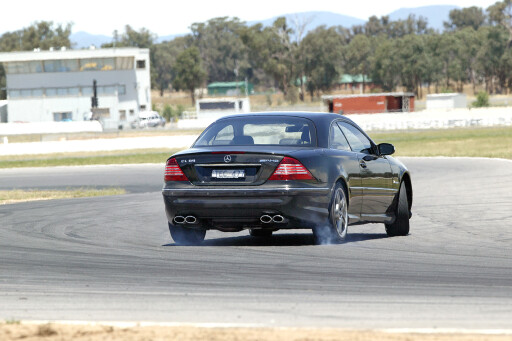 It still lacks a little front-end grip, but it does steer and point pretty well (in C-Class tradition). The overall set-up is still too soft for really hard pedalling, but 1:43.67 shows the CL65 how it’s done and proves that grunt ain’t everything. That’s if you can ignore the body roll and actually get your head around the gearbox.
It still lacks a little front-end grip, but it does steer and point pretty well (in C-Class tradition). The overall set-up is still too soft for really hard pedalling, but 1:43.67 shows the CL65 how it’s done and proves that grunt ain’t everything. That’s if you can ignore the body roll and actually get your head around the gearbox.
See, for many of us, that recalcitrant auto simply made the job too hard and really not worth the bother. Why is it that the German stuff we attract to PCOTY is always big-dollar gear? Then again, who gives a monkey’s when it’s as good at Winton as the new 997 version of the 911.
Actually, that’s the point, really: It might cost an arm and a leg, but the 911 is so proficient on the track, you’ll come away swearing to yourself that it’s worth every shekel. Despite tyres that were well shagged, the Carrera S belies the model’s reputation for twitchy handling.
Yes, it does still move around at the back a bit, but it gives heaps of warning and then never really goes on with the nasty stuff anyway. Our only complaint would be the active damping, which is possibly less relevant on a racetrack than on the road (and yeah, I know it’s a road car first and foremost) and seems to have stolen a fraction of that legendary 911 steering feel.
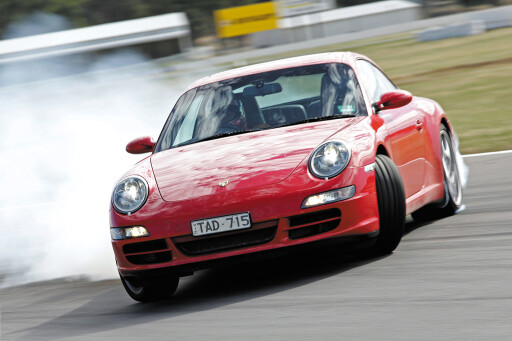 A 1:38.25 meant the Porsche was one of only two cars to dip below 1:40, and was the fastest lapper all day by almost a full second. The other track-day hero is the Lotus Exige now, like the Elise 111R model, with Toyota power lifting its claim to 141kW.
A 1:38.25 meant the Porsche was one of only two cars to dip below 1:40, and was the fastest lapper all day by almost a full second. The other track-day hero is the Lotus Exige now, like the Elise 111R model, with Toyota power lifting its claim to 141kW.
Combine that with just 887kg, and even if the Lotus didn’t handle, it’d still be entertaining. In any case, it does handle – boy does it handle – and on the smooth hotmix at Winton, the Exige is truly, utterly in its element.
It feels even more hard-edged than the Elise (if that’s possible) and all the Lotus hallmarks like the tiny tiller, non-assisted steering or brakes, alloy floor panels and ultra-mechanical feeling shifter add up to a pretty intense experience. It could just about be the perfect track day tool.
It’s tight, neutral and totally grippy, both in a tyre and a general sense and refuses to give up, even after you’ve gone in way deeper than you might have intended. A lap-time of 1:39.17 confirms that much. The fact that, 70 or 80 years ago, all sports cars were convertibles is still reflected at PCOTY where we usually end up with a soft-top or two.
 Blurring the lines more than a little is the Benz SLK350 which is a hard-top that folds away to become a convertible. Best of both worlds? Maybe, but the weight of the steel lid and the mechanisms to fold it account for a fair chunk of the 1465kg kerb weight.
Blurring the lines more than a little is the Benz SLK350 which is a hard-top that folds away to become a convertible. Best of both worlds? Maybe, but the weight of the steel lid and the mechanisms to fold it account for a fair chunk of the 1465kg kerb weight.
And that mood continues throughout the vehicle which just generally feels a bit dulled on a track like Winton. It’s probably still better than most people would give it credit for, and it’s completely neutral in, through and out of a corner, but the responses it feeds back aren’t exactly vibrant.
The brakes are also dead feeling, the gearshift is sticky and a bit heavy and the clutch is clunky and rubbery. But here’s the catch, with a 1:44.35, it’s quicker than a Falcon GT-P. Spooky. The other drop-top is a more conventional customer and Mazda’s MX-5 SE is the last in a long, long line of little sexpots to bear the MX-5 tag.
But that’s the point; in a lot of ways, the Mazda is really starting to show its age and the flexy body (relatively speaking, you understand) non-adjustable steering column and cramped cockpit are the clues that the SE can trace its roots right back to about 1989.
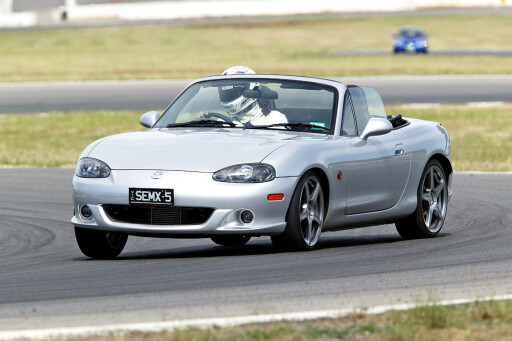 While the MX-5 feels reasonably fit, it doesn’t necessarily feel particularly quick on a track. The quick, almost darty steering remains to entertain even if both the clutch and brake pedals were squeaky. A lap-time of 1:47 dead isn’t, however, the stuff of bragging rights.
While the MX-5 feels reasonably fit, it doesn’t necessarily feel particularly quick on a track. The quick, almost darty steering remains to entertain even if both the clutch and brake pedals were squeaky. A lap-time of 1:47 dead isn’t, however, the stuff of bragging rights.
Of the big locals, the CV8 was perhaps the real surprise package. Given that the SS was a DNF, the Monaro was left to carry the flag for the Gen III brigade. The interesting thing is the way the CV8 felt sharp and responsive in the front end (much better than the SS, despite the four-door’s full VZ specification) and yet had plenty of power-down and grip at the noisy end.
It could be hurled around as well as any other full-sized Holden we’ve sampled and it was actually a fair bit of fun into the bargain. Maybe it’s just because we’re now getting used to the urge of the Gen IV, but the Monaro’s engine felt like it really needed to be wrung right out to deliver full satisfaction.
Making it scream right up to about 6000rpm was the key, although it hardly felt like you were treating the thing with much respect in the process. The brakes were a bit of a disappointment, too. They felt weedy and could be coaxed into starting to fade, the first symptom being a wooden feel through the pedal.
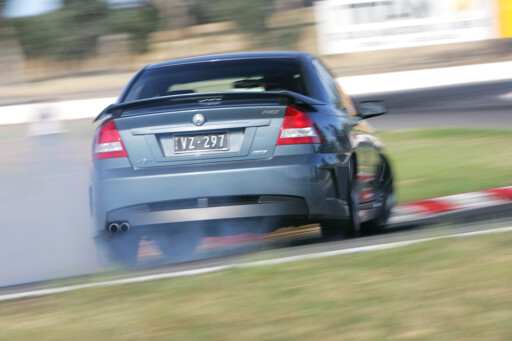 Ultimately 1:44.47 didn’t seem too bad to us. Meanwhile, over at HSV, the Gen IV has got everybody talking. Us too, because it’s one hell of a lump. The torque off the bottom end addresses all our complaints with the Gen III. The rest of the Clubbie package remains which is no bad thing, because the whole R8 thing has impressed us on the last couple of outings.
Ultimately 1:44.47 didn’t seem too bad to us. Meanwhile, over at HSV, the Gen IV has got everybody talking. Us too, because it’s one hell of a lump. The torque off the bottom end addresses all our complaints with the Gen III. The rest of the Clubbie package remains which is no bad thing, because the whole R8 thing has impressed us on the last couple of outings.
The big fella isn’t super agile, and it does continue to feel pretty weighty, but the flip-side is better than average steering feel and accuracy. And while the big tyres and general set-up confer good grip, there’s always enough grunt on tap to overcome that.
The front pews seem to have lost a lot of the lateral support that made the previous model’s so damn good, but that couldn’t stop the R8 posting a 1:44.07. And while the addition of a power-steering cooler should have fixed the woes in that department, we still managed to boil the fluid once the engine had been shut down back in the pits.
By comparison with the Clubbie, the HSV GTO just didn’t rise to the challenge. A 1:45.62 is well off the pace for a Gen IV-powered vehicle, and is over a second off the pace recorded by the allegedly humbler Monaro CV8 which has neither the big mutha mill nor the HSV badges.
Whether it was just an off-colour car we don’t know, but we can tell you the thing – even compared directly with the R8 – just felt heavy, slow and unresponsive. Dull, probably covers it.

COMMENTS